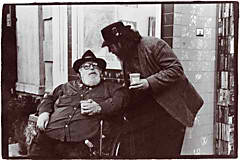
Few white pop-rock songwriters of the 1950s and '60s started out as miserably as Jerome Felder. Polio-stricken at age 7, Felder was placed in body casts and then an iron lung before he wound up in leg braces and crutches. Stuck in bed for years, Felder spent a lot of time listening to the radio, which is where he discovered Big Joe Turner belting out Piney Brown Blues. Felder identified with the blues, which spoke to his own misfortune.
One day when he was 17 years old, Felder got dressed in a suit and tie and left his parents' apartment in Brooklyn. He took the subway into Manhattan to hear trumpeter Frankie Newton. But when the club owner saw him—with the leg braces and crutches and awkward crab-like movements to get around—he demanded to know why Felder was there. Felder lied and told him he was a blues singer. “A blues singer, eh?" the manager said, hands on his hips. “Then why don't you get up there and sing."
So Felder did. And he was an instant hit. He soon began gigging as a blues shouter for $40 a week. But if he was going to keep his job, he needed a better name. “Jerome Felder" wasn't going to cut it on the posters outside, and he didn't want his mother to find out what he was doing. So he took Doc from Doctor Clayton [above]—a blues singer-songwriter—and Pomus from who knows what. As Pomus says in the new documentary, AKA Doc Pomus, which opens today in New York and nationally next week, “It just sounded right."
For the next 10 years—from 1945 to 1955—Pomus [above] performed in clubs and recorded about 50 sides as a blues shouter. People who heard him never suspected he was white. That's because his voice was earthy and bore the scars of pain, loneliness and suffering. Then Big Joe Turner heard Pomus and recommended him to Atlantic co-founder Ahmet Ertegun. Hired to write R&B, Pomus began writing for Turner and learned everything he needed to know about putting across a song.
Then came Pomus' Lonely Street in 1956 for Ray Charles, which became a hit. In 1958 Pomus teamed with Mort Shuman, who wrote the music while Pomus wrote the lyrics. Together, they wrote more than 1,000 songs, including A Teenager in Love, Save The Last Dance For Me, Hushabye, This Magic Moment, Sweets For My Sweet, Little Sister, A Mess of Blues and Can't Get Used to Losing You.
In the '70s, his life fell apart and in the '80s he underwent a revival. A heavy smoker, Pomus died in 1991 at age 65 of lung cancer.
In today's Wall Street Journal, I preview AKA Doc Pomus (go here or please buy the paper).
JazzWax tracks: Doc Pomus' blues shouting sides can be found on Doc Pomus: Singer and Songwriter (Jasmine), a 56-song release that can be downloaded for $8.99. Go here.
JazzWax clips: Here's the trailer for AKA Doc Pomus...
Here's Doc Pomus on Savoy with the Curley Russell All Stars: Doc Pomus (vcl), Bill Moore (tp), Jesse Powell and Ray Abrams (ts), Reggie Ashby (p), Herman Mitchell (g), Curly Russell (b) and Arthur Herbert (d)...
One day when he was 17 years old, Felder got dressed in a suit and tie and left his parents' apartment in Brooklyn. He took the subway into Manhattan to hear trumpeter Frankie Newton. But when the club owner saw him—with the leg braces and crutches and awkward crab-like movements to get around—he demanded to know why Felder was there. Felder lied and told him he was a blues singer. “A blues singer, eh?" the manager said, hands on his hips. “Then why don't you get up there and sing."
So Felder did. And he was an instant hit. He soon began gigging as a blues shouter for $40 a week. But if he was going to keep his job, he needed a better name. “Jerome Felder" wasn't going to cut it on the posters outside, and he didn't want his mother to find out what he was doing. So he took Doc from Doctor Clayton [above]—a blues singer-songwriter—and Pomus from who knows what. As Pomus says in the new documentary, AKA Doc Pomus, which opens today in New York and nationally next week, “It just sounded right."
In the '70s, his life fell apart and in the '80s he underwent a revival. A heavy smoker, Pomus died in 1991 at age 65 of lung cancer.
In today's Wall Street Journal, I preview AKA Doc Pomus (go here or please buy the paper).
JazzWax tracks: Doc Pomus' blues shouting sides can be
JazzWax clips: Here's the trailer for AKA Doc Pomus...
Here's Doc Pomus on Savoy with the Curley Russell All Stars: Doc Pomus (vcl), Bill Moore (tp), Jesse Powell and Ray Abrams (ts), Reggie Ashby (p), Herman Mitchell (g), Curly Russell (b) and Arthur Herbert (d)...
This story appears courtesy of JazzWax by Marc Myers.
Copyright © 2025. All rights reserved.





























